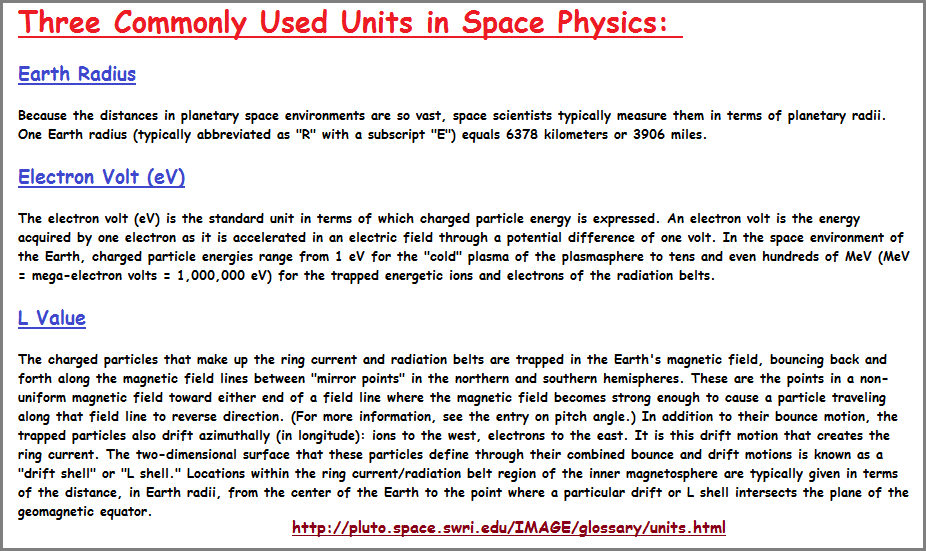~ 12 ~
~ The Study of Threes ~
http://threesology.org
Researchers as of 8/29/2019
| Devil's Advocate Series: | ||||||||
|---|---|---|---|---|---|---|---|---|
| 1 | 2 | 3 | 4 | 5 | 6 | 7 | 8 | 9 |
| 10 | 11 | 12 | 13 | 14A 14B |
15 | 16 | 17 | 18 |
| 19 | 20 | 21 | 22A 22B |
23 | 24 | 25 | 26 | 27 |
| 28 | 29 | 30 A | 30 B | 31 | 32 | 33a | 33b | 33c |
| 34 | 35 | 36 | 37 | 38 | 39 | 40 | 41 A | 41 B |
While the foregoing was a digression dealing analogously with the three topics of consumers, producers and distribution found in different subjects, the organizing theme of "three" is brought back into the topic as a centralized focus of inquiry which is applied to materials of investigation such as the development of life with its two-patterned timelines involving a comparison of geology and biology. From here the discussion resumes when we identify that the planetary events are customarily grouped in with the geological events with respect to the origin of the Earth, Moon and Sun/solar system, as well as associated impacts from asteroids and meteorites. Geology has taken center stage as a defining character trait in which to support biological events, and not necessarily the reverse of this. While there are different timelines which are used to describe focused periods of time and events concerning one or a few biological events, all timelines fail to include the three on-going events which no doubt have had and continue to have some effect on both the geology and biology being illustrated. Namely, and please note I will repeat this scenario; there are three planetary events which need to be taken into active account even though they are taking place on what we humans may perceive to be incremental deteriorations:
- The Sun's energy is burning out and it is thought that in later stages it will enlarge to engulf the inner-most three planets (Mercury, Venus, Earth).
- The Earth's Rotation is slowing down. This means we must ask the question Are Humans Rotation Rate Specific?. Indeed, is all of life constrained to rotation rate specificities, though adaptation may be applicable to some... yet not all? A slowing rotation also affects the geo-dynamo of the Earth's core/mantel interactions and the resulting geo-magnetism... as well as wind patterns.
- The Moon is receding (moving away) from the Earth, causing an alteration in the "washing machine" effect of the tides.
Humanity can not afford the luxury of ignorance which argues that the effects of the Sun will take billions of years and therefore humanity doesn't need to concern itself with this, or any of the incrementally deteriorating planetary events. The life span of humanity may well be akin to the short-lived cycle witnessed in the fruit (vinegar) fly known as Drosophila used in genetics experiments. There is often-times too much ego which comes into play when humans analyze themselves and their assumed place in the Universe. Relative to human terms of activity, humanity may live out a life cycle akin to its own variation of the fruit fly's life span.
- The Sun's ultra-violet irradiation was more intense billions of years ago due to an absence of oxygen, and less intense now due to the three-molecule form of oxygen called ozone which reduces the intensity... as the Sun continues on its course of burning out and expanding. The rather inhospitable environment gave rise to prebiotic events which worked well in such an absence of oxygen. Here is a one- two- three illustration of oxygen:
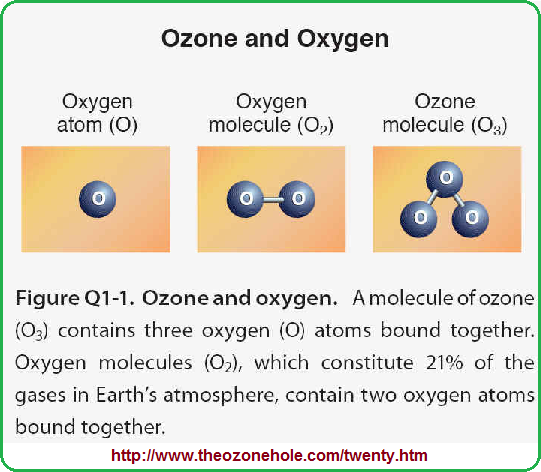
While we do not know what the surface temperature of the Earth was billions of years ago, much less the value of the Sun's irradiation, the image below may provide a hint of variables we need to keep in mind while we visually attempt to create early Earth conditions in which biological and pre-biological materials were subjected to and reacted with accommodated adaptations:
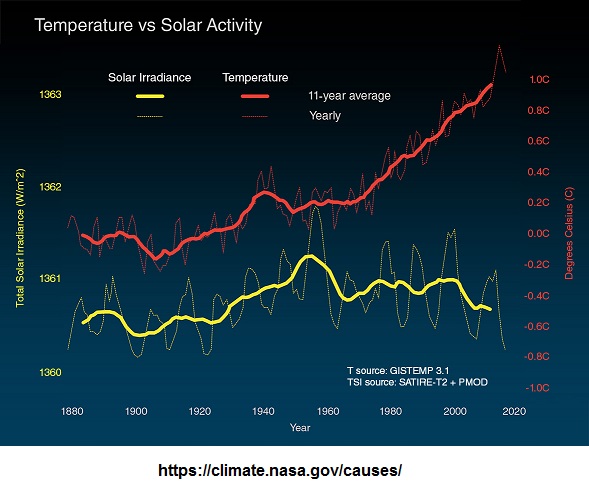
- The third planet from the Sun (Earth) was spinning much faster billions of years ago during the oxygen depleted time period of early life processes just as it continues to lose rotational momentum affecting the geomagnetic core and its relationship with both the Sun and Moon. A fast spinning Earth subjected to the Sun creates a condition of "strobe-lighting" which, based on speed of rotation, created a successive staging of one (sunlight immersion), then two (the day/night sequencing), followed by three (dawn- noon- dusk phase ranges effecting a three-patterned mimicry...so to speak), which is being followed by a 3-in-1 fusion of the Sun's three "moments" as the Earth slows and the Sun expands.
| A fast spinning Earth under a hot Sun caused an environmental scenario of a one-patterned daylight immersion. I do not know what color the daylight would have been. However, according to this article: Earth's Oldest Color Dates Back More Than 1 Billion Years, the color pink was in vogue at this time, but some other color, or even non-color may have been around billions of years earlier. | A slowing Earth coupled with a presumed slowly increasing oxygen atmosphere introduced biology making components to a two-patterned day/night sequence. (The idea of a Faint young Sun Paradox and a reduced oxygen atmosphere have advocates and dissenters.) | Continued slowing of the Earth coupled with an increasing oxygen content, subjected the development of biological matter to a three-patterned dawn-noon-dusk phasing, suggesting this may have been the originating influence of the triplet code in DNA. |
- The Moon was once much closer to Earth Billions of years ago and thus loomed larger in the sky and caused larger fluctuations of tidal behavior as well as creating a more significant "bulging" effect on the Earth.
The Moon is thought to have formed when an object roughly the size of Mars hit the Earth. The impact was so violent that it threw large amounts of the Earth's mantle into orbit. This material eventually coalesced and formed the Moon.
It is not easy to estimate how far away from the Earth the Moon was when it formed, but simulations suggest is was about 3-5 times the radius of the Earth, or about 20 to 30 thousand kilometers. (The Moon is currently about 384,000 km or 60 Earth radii away from Earth, which is about fifteen times further away than it was when it first formed.) The Moon probably couldn't have formed closer than 3 Earth radii because tidal forces from the Earth would just pull it apart again, and it is unlikely that the impact could have ejected material further than 5 Earth radii. It's not a totally easy questions to answer though as it depends a lot on the (unknown) details of the impact and how the hot material behaved in space.
The exact rate of the Moon's movement away from Earth has varied a lot over time. It depends both on the distance between the Earth and the Moon, and the exact shape of the Earth. The details of continents and oceans moving around on Earth actually change the rate, which make it a very hard thing to estimate. The rate is currently slowing down slightly, and it is estimated that in about 15 billion years the Moon's orbit will stop increasing in size.
Cornell University: Ask an Astronomer
Here is a Pythagorean theorem (3,4,5) list of Moon formation theories:
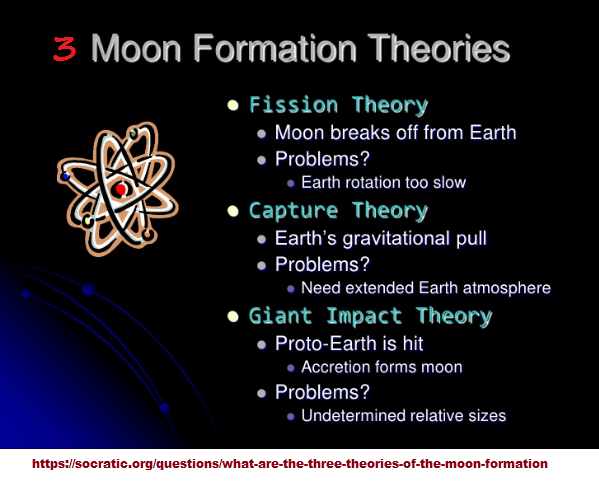
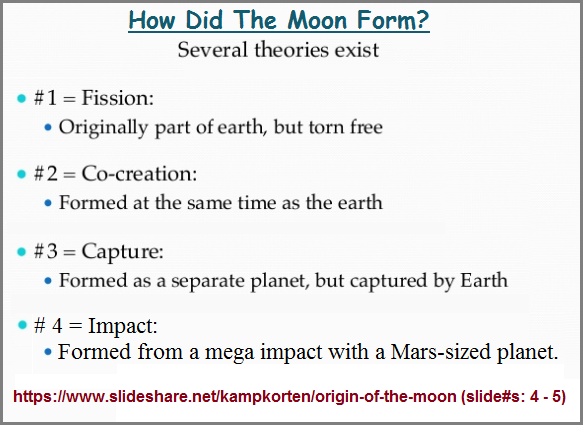
Five theories on the formation of the moon... and like all the rest, do not directly tell us what will occur to the Moon and Earth's relationship in the Future. Such an analyses requires more data. Here's one article discussing the Moon's future course: Earth's Moon Destined to Disintegrate By David Powell January 22, 2007 Science & Astronomy
|
Was the world an orange color 4 billion years ago?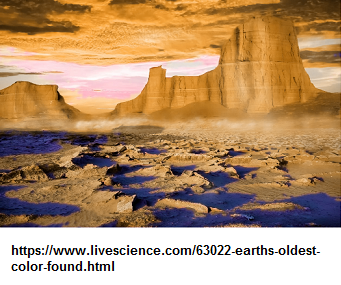 |
Was the world a pink color 1 billion years ago?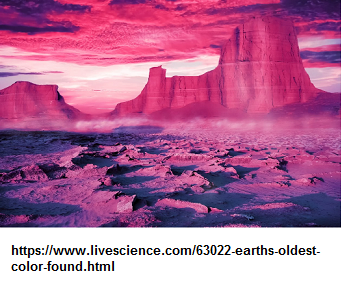 |
In discussing what color the sky or "daylight" was billions of years ago, one might suggest looking from the perspective of different planets, but this poses problems because of distances, rotation speeds, environmental composition, etc... Nonetheless, one might want to consider this angle of inquiry: Extraterrestrial skies, or: What color is the Sky on other Planets?, or then again:
- Orange sky 3.7 billion years ago because there was little oxygen?
- What color were earth's sky and oceans prior to the Great Oxygenation Event?
In discussing color, let us remind ourselves that:
- There is a 3-to-1 ratio with human eyes, in that we have three color cones (Red [short-wavelength]- Green [medium-wavelength]- Blue [long-wavelength]) and 1 rod (for night, or low light vision). However, a few exhibit a fourth cone called Tetrachromacy
- Human eyes mix light (with the primary colors Red- Green- Blue), while pigments are mixed in video production, art as well as print production, the primary colors are cyan, magenta and yellow. If the Color Pink Doesn't Scientifically Exist, Why Can We See It?
- Color sightedness and color blindness may occur in an episodic form at times, just as perceptions can be distorted from time to time.
- The visual spectrum is a small segment of the larger electromagnetic spectrum. We do not know to what extent such a spectrum affects the "perception" or behavior of different biological and non-biological substances.
With respect to the visual spectrum in which the variations (or rainbow) of colors is commonly presented in various types of illustrations being adopted for different orientations, it should be brought up in the context of early biological development and the "color" of the environment which early biologically directed substrates were subjected to... but not necessarily that could be perceived. The point I want to make is that in attempting to discover what the color of the environment was billions of years ago and how it may have changed, I want to introduce the view that the color spectrum appears to reflect (or is that refract or diffract?) the color of the atmosphere as it has changed over billions of years:
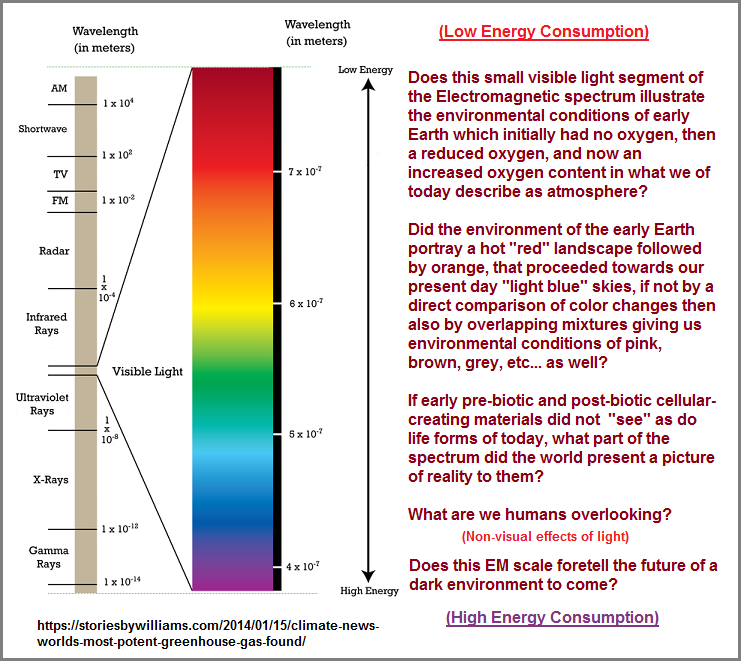
- Unlike art production (see below), when it comes to eyesight (and video production), the primary colors are red, green and blue.
- The old two-photoreceptor idea of Rods and Cones has given way to the discovery of a third photoreceptor system of the eye: Retinal ganglion cells (pRGCs)
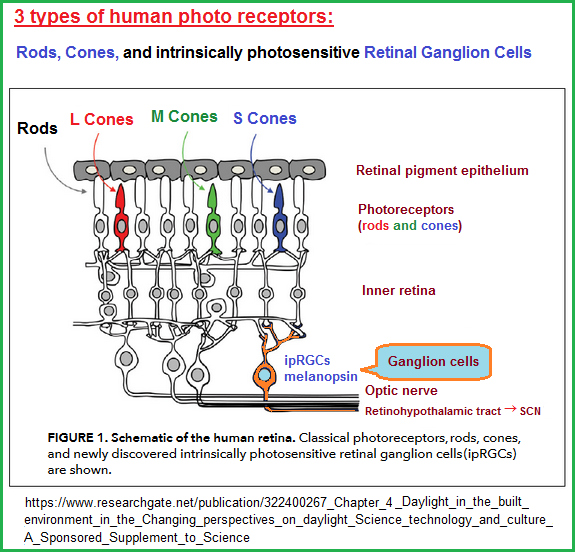
At this point let me introduce a third variable in the geology/biology dichotomy used in timelines, since the rate of the Earth's rotation can be mapped out along with the geology and biology events, suggesting that such events are "specific" to the rotation rates which occurred. If this assumption is correct, then we have a variable distinguished by the notion of "rotation rate specificity":
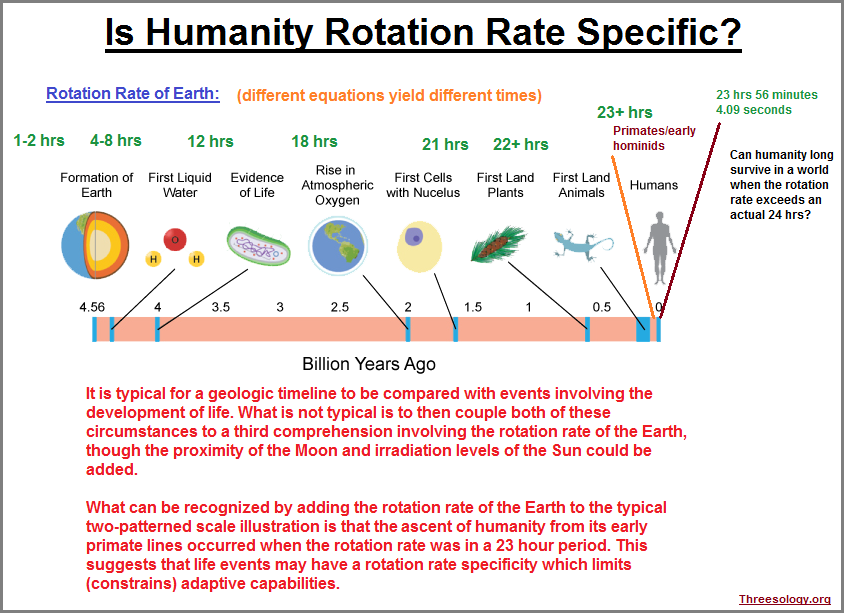
Even though I thrust myself into the role of being my own Devil's Advocate, this character trait is likewise extended into the examination of the patterns being used by established authority as well as those which become emphasized by social usage as a convention or urban legend types of beliefs. In other words, in looking for specific patterns, I also look at the patterns within patterns in an attempt to recognize overlooked patterns that the pattern makers have overlooked or decided to focus more on one type than another, whether or not the experts or educated public debates one or another usage of a given pattern's overall usefulness. Frequently I find that the patterns being used are not themselves being subjected to some pattern which is interrelating the patterns in all subject areas. Experts as well as the general public often have blinders on either constructed by established practices of a given discipline, or because of the social/cultural environment they inhabit... if not the restraints of human cognitive processing anyway. Let me provide an example of a pattern within a pattern that does not take into consideration an overall pattern existing amongst other subject areas which details a recurring limitation in human cognitive processing within the parameters of all subject areas and can not easily be explained (or "justified") by supporting the claim that the patterns being recognized are part of the subject matter itself when it is clear that human cognition is part of the subject matter as well, but is being taken for granted, suggesting that the patterns being recognized may be projections of an underlying preference, impulse, inclination... or otherwise labeled orientation originating from within the design of the human brain/mind/physiology:
The Penguin Dictionary of Biology, eleventh addition Introduction to the tenth edition: To illustrate the controversies within plant taxonomy, here are just two of many current issues, both involving flowering plants. The recent tradition of flowering plant taxonomy has been to split this division into monocotyledons (now termed Liliopsida) and Dicotyledons (now termed Magnoliopsida) — a partition justified by the clustering of several observable characters, including cotyledon number. But some research groups evaluating DNA sequences suggest that the real split among flowering plants lies elsewhere. One such group (at the Royal Botanical Gardens, Kew) identifies the major morphological distinction in the flowering plants not with cotyledons but with the anatomy of the basic pollen type. They conclude that magnolia — traditionally a 'primitive dicot', but with a single pollen grain spore rather than the three pollen grain furrows of dichots — has closer evolutionary links with traditional monocots such as bamboos and lilies than it does with other plants having two seed leaves. This would lead to a change in the criteria for membership of the two major flowering plant divisions. As a second illustration, four independent groups of DNA sequencers in the USA have, to majority surprise, produced flowering plant phylogenies implicating Amborella a genus of New Caleodonian shrub, as the closest living relative of the first flowering plants. Both examples, if valid, will necessitate reconstruction of current plant classifications. |
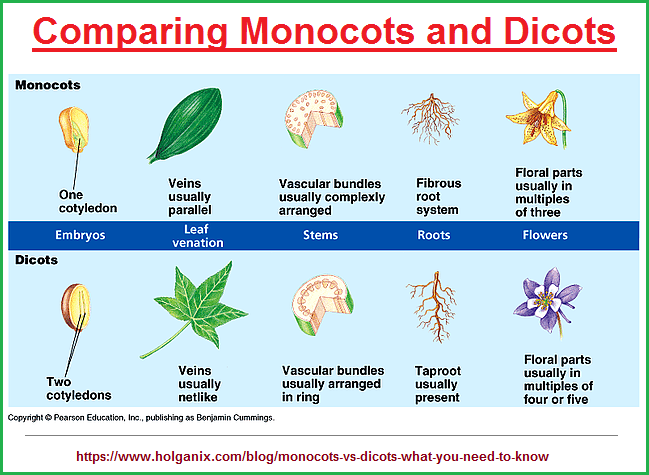 |
 |
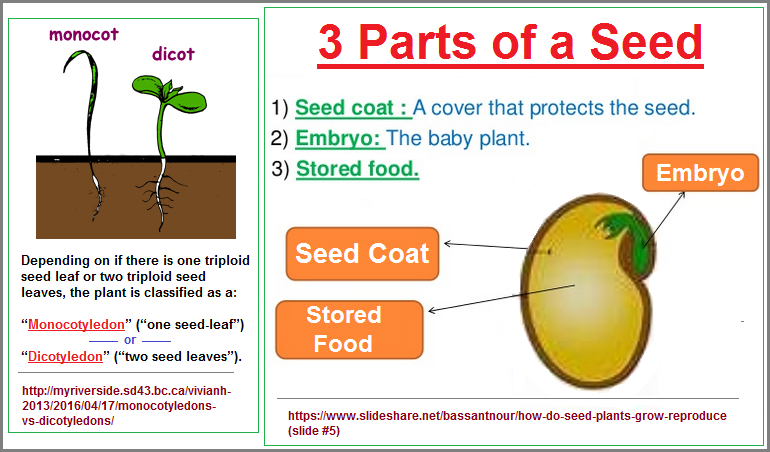 |
Three groups of secondary metabolites in plants:
All plant parts exposed to the atmosphere are coated with layers of non-polar lipid material (Cutin, Waxes, and Suberins) that reduce water loss and help block the entry of pathogen fungi and bacteria. Mechanical defenses in plants:
Most chemical defenses (other than tannin production) are offshoots of normal metabolic pathways in the leaves. An outline of 'normal' and secondary product metabolism reveals that there is a close metabolic relationship among many toxic, pharmaco-active and inhibitory defenses. Information sources: |
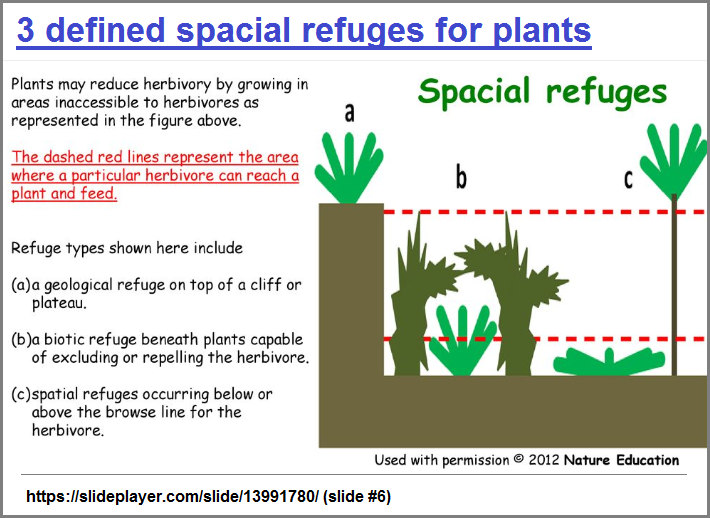 |
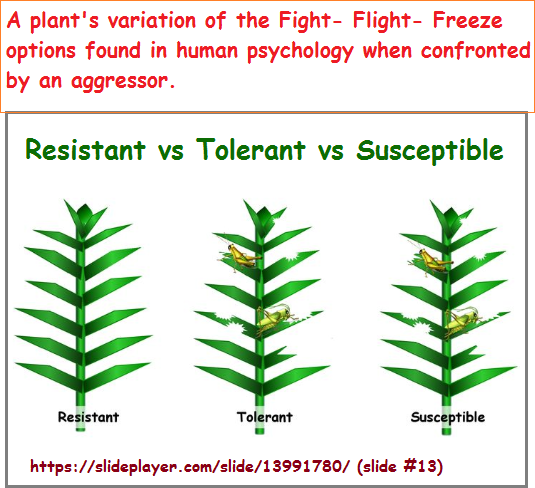 |
While it is frequent to hear the above titled expression, a lesser known one is "leaves of five, let them thrive". Other than this, we have not prominent reference to an enumerated sequence concerning plants, unless we were to count explorations of the Fibonacci series of number patterns in Nature, or indulge in some more extensive research interest where enumeration is a regularly used tool of identification. In some instances one might consider that the alternative expressions were up by those wanting to impart their two-cents into the fray so that they too could be remembered... if not by name, then by the idea they created. Here are some examples of the "leaves of three expression and accompaniments":
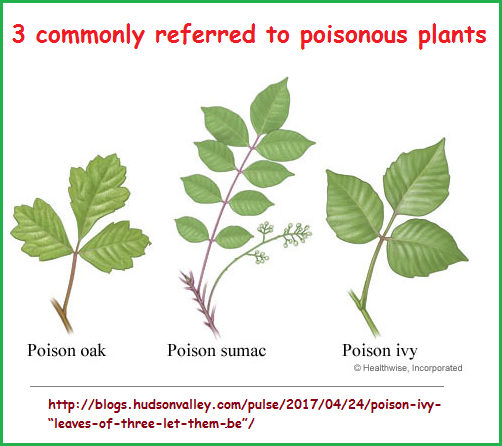 |
Basic, enumerated patterns are used in the study of plants and other subjects. Yet, the pattern of the patterns is not being looked at as an overall indication of human evolution itself, as a living organism amongst many other life forms. (Like the enumerated pattern seen in DNA, suggesting that the information coded in what has been termed the "selfish gene" coined by Richard Dawkins. However, I disagree with the idea that the selfish gene is immortal and is more an expression of human projected arrogance onto an interpretation in an attempt to magnify some presumed importance of a consideration. In short, it is considered that Dawkin's Selfish Gene Theory Of Evolution Called Fatally Flawed. (You might also like: Are genes really selfish?)
In addition, though the role of DNA has been diminished by this suggestion of a selfish gene, we must include DNA, RNA and proteins in this selfishness... in that they are what is important for life— while the many life forms are little more than vehicles being used for the survival of this trio of companions having established a monopoly in the economics of biology.) Oh so very often we can find a "three-patterned" structure that may or not be part of a readily visible one-two-three maturational or evolutionary formula. Indications of a close developmental inter-relationship may not be readily visible or for that matter, even come to the mind of a given researcher as a possibility for the existence of one or another example being studied. Sometimes the earlier forms that could be enumerated (with lower numbers) have been lost to time such as because of deterioration, overlap, erosion, extinction, etc...
You can listen to Richard Dawkins as he explains his "selfish gene" idea:
For example, while we can find examples of two- (diploblastic) and three- (triploblastic) germ layered animals, such is not the case for a one- ("monoploblastic") germ layered representation, though the sponge has sometimes been relegated to this position. One germ layer life forms may all be extinct or that the one germ layer was initially part of what we may describe as a proto-layer development. In any case, the two and three- patterns are distinguishable. (The animal group labeled the Cnidaria (aquatic life forms) are examples of a two-germ layer model and animals catalogued under the heading of Bilateria are an example of animals with three-germ layers).
In those cases where we see a more-than-three organization (4, 5, 6, 7, 8...), to me this does not express a refutation of a "threes" research focus as having some reputable meaning and viable application, instead I think this points out that life has an ability to push beyond the recurring one-two-three sequencing of development, but that only in some cases does this ability show itself. It suggests that something is restricting development from a great multiplicity (beyond the recurring one-two-three... pattern), though the large assortment of life forms is interpreted by some to suggest otherwise. Instead of a "beyond-the-three" interpretation to be used as a stick to beat over the heads of those interested in the threes phenomena research, I see that there are multiple examples of a recurring representation of the one-two-three that are not being adequately catalogued as an expression of evolution itself, with variations of this recurring pattern (seen in partial or full form), to be noted and catalogued as an instance indicating that a life form "broke" the typical mold... the recurring pattern, whether by mutation or otherwise. If life is as divergent as some claim. then even the triplet coding system of DNA and RNA should not be a constraint... but it is, and we must figure out why; because this constraint suggests an environmental imposition tied to the ongoing incremental deterioration of the planet... further suggesting that the recurring low numbers in our classification schemas are a tell-tale sign of a forthcoming extinction so long as we remain on this planet in our human form. The low numbers are a product of the evolutionary processes on this planet with its imposing requirements of constraint as a survival mechanism... a mechanism which is following a path of decadence in its efforts to sustain some measure of equilibrium.
Origination date: Wednesday, September 4th, 2019... 1:58 AM
Initial Posting: Wednesday September 4th, 2019... 10:29 AM
Updated Posting:Tuesday, January 17th, 2023... 12:18 AM
Herb O. Buckland
herbobuckland@hotmail.com
